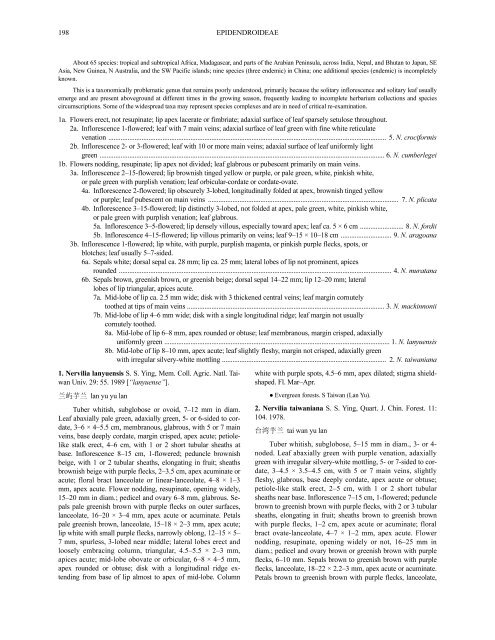Create successful ePaper yourself
Turn your PDF publications into a flip-book with our unique Google optimized e-Paper software.
198<br />
EPIDENDROIDEAE<br />
About 65 species: tropical and subtropical Africa, Madagascar, and parts of the Arabian Peninsula, across India, Nepal, and Bhutan to Japan, SE<br />
Asia, New Guinea, N Australia, and the SW Pacific islands; nine species (three endemic) in China; one additional species (endemic) is incompletely<br />
known.<br />
This is a taxonomically problematic genus that remains poorly understood, primarily because the solitary inflorescence and solitary leaf usually<br />
emerge and are present aboveground at different times in the growing season, frequently leading to incomplete herbarium collections and species<br />
circumscriptions. Some of the widespread taxa may represent species complexes and are in need of critical re-examination.<br />
1a. Flowers erect, not resupinate; lip apex lacerate or fimbriate; adaxial surface of leaf sparsely setulose throughout.<br />
2a. Inflorescence 1-flowered; leaf with 7 main veins; adaxial surface of leaf green with fine white reticulate<br />
venation ............................................................................................................................................................... 5. N. crociformis<br />
2b. Inflorescence 2- or 3-flowered; leaf with 10 or more main veins; adaxial surface of leaf uniformly light<br />
green ................................................................................................................................................................... 6. N. cumberlegei<br />
1b. Flowers nodding, resupinate; lip apex not divided; leaf glabrous or pubescent primarily on main veins.<br />
3a. Inflorescence 2–15-flowered; lip brownish tinged yellow or purple, or pale green, white, pinkish white,<br />
or pale green with purplish venation; leaf orbicular-cordate or cordate-ovate.<br />
4a. Inflorescence 2-flowered; lip obscurely 3-lobed, longitudinally folded at apex, brownish tinged yellow<br />
or purple; leaf pubescent on main veins ............................................................................................................. 7. N. plicata<br />
4b. Inflorescence 3–15-flowered; lip distinctly 3-lobed, not folded at apex, pale green, white, pinkish white,<br />
or pale green with purplish venation; leaf glabrous.<br />
5a. Inflorescence 3–5-flowered; lip densely villous, especially toward apex; leaf ca. 5 × 6 cm ......................... 8. N. fordii<br />
5b. Inflorescence 4–15-flowered; lip villous primarily on veins; leaf 9–15 × 10–18 cm ............................. 9. N. aragoana<br />
3b. Inflorescence 1-flowered; lip white, with purple, purplish magenta, or pinkish purple flecks, spots, or<br />
blotches; leaf usually 5–7-sided.<br />
6a. Sepals white; dorsal sepal ca. 28 mm; lip ca. <strong>25</strong> mm; lateral lobes of lip not prominent, apices<br />
rounded ............................................................................................................................................................ 4. N. muratana<br />
6b. Sepals brown, greenish brown, or greenish beige; dorsal sepal 14–22 mm; lip 12–20 mm; lateral<br />
lobes of lip triangular, apices acute.<br />
7a. Mid-lobe of lip ca. 2.5 mm wide; disk with 3 thickened central veins; leaf margin cornutely<br />
toothed at tips of main veins ................................................................................................................. 3. N. mackinnonii<br />
7b. Mid-lobe of lip 4–6 mm wide; disk with a single longitudinal ridge; leaf margin not usually<br />
cornutely toothed.<br />
8a. Mid-lobe of lip 6–8 mm, apex rounded or obtuse; leaf membranous, margin crisped, adaxially<br />
uniformly green ................................................................................................................................. 1. N. lanyuensis<br />
8b. Mid-lobe of lip 8–10 mm, apex acute; leaf slightly fleshy, margin not crisped, adaxially green<br />
with irregular silvery-white mottling .............................................................................................. 2. N. taiwaniana<br />
1. Nervilia lanyuensis S. S. Ying, Mem. Coll. Agric. Natl. Taiwan<br />
Univ. 29: 55. 1989 [“lanyuense”].<br />
兰屿芋兰 lan yu yu lan<br />
Tuber whitish, subglobose or ovoid, 7–12 mm in diam.<br />
Leaf abaxially pale green, adaxially green, 5- or 6-sided to cordate,<br />
3–6 × 4–5.5 cm, membranous, glabrous, with 5 or 7 main<br />
veins, base deeply cordate, margin crisped, apex acute; petiolelike<br />
stalk erect, 4–6 cm, with 1 or 2 short tubular sheaths at<br />
base. Inflorescence 8–15 cm, 1-flowered; peduncle brownish<br />
beige, with 1 or 2 tubular sheaths, elongating in fruit; sheaths<br />
brownish beige with purple flecks, 2–3.5 cm, apex acuminate or<br />
acute; floral bract lanceolate or linear-lanceolate, 4–8 × 1–3<br />
mm, apex acute. Flower nodding, resupinate, opening widely,<br />
15–20 mm in diam.; pedicel and ovary 6–8 mm, glabrous. Sepals<br />
pale greenish brown with purple flecks on outer surfaces,<br />
lanceolate, 16–20 × 3–4 mm, apex acute or acuminate. Petals<br />
pale greenish brown, lanceolate, 15–18 × 2–3 mm, apex acute;<br />
lip white with small purple flecks, narrowly oblong, 12–15 × 5–<br />
7 mm, spurless, 3-lobed near middle; lateral lobes erect and<br />
loosely embracing column, triangular, 4.5–5.5 × 2–3 mm,<br />
apices acute; mid-lobe obovate or orbicular, 6–8 × 4–5 mm,<br />
apex rounded or obtuse; disk with a longitudinal ridge extending<br />
from base of lip almost to apex of mid-lobe. Column<br />
white with purple spots, 4.5–6 mm, apex dilated; stigma shieldshaped.<br />
Fl. Mar–Apr.<br />
● Evergreen forests. S Taiwan (Lan Yu).<br />
2. Nervilia taiwaniana S. S. Ying, Quart. J. Chin. Forest. 11:<br />
104. 1978.<br />
台湾芋兰 tai wan yu lan<br />
Tuber whitish, subglobose, 5–15 mm in diam., 3- or 4noded.<br />
Leaf abaxially green with purple venation, adaxially<br />
green with irregular silvery-white mottling, 5- or 7-sided to cordate,<br />
3–4.5 × 3.5–4.5 cm, with 5 or 7 main veins, slightly<br />
fleshy, glabrous, base deeply cordate, apex acute or obtuse;<br />
petiole-like stalk erect, 2–5 cm, with 1 or 2 short tubular<br />
sheaths near base. Inflorescence 7–15 cm, 1-flowered; peduncle<br />
brown to greenish brown with purple flecks, with 2 or 3 tubular<br />
sheaths, elongating in fruit; sheaths brown to greenish brown<br />
with purple flecks, 1–2 cm, apex acute or acuminate; floral<br />
bract ovate-lanceolate, 4–7 × 1–2 mm, apex acute. Flower<br />
nodding, resupinate, opening widely or not, 16–<strong>25</strong> mm in<br />
diam.; pedicel and ovary brown or greenish brown with purple<br />
flecks, 6–10 mm. Sepals brown to greenish brown with purple<br />
flecks, lanceolate, 18–22 × 2.2–3 mm, apex acute or acuminate.<br />
Petals brown to greenish brown with purple flecks, lanceolate,
















